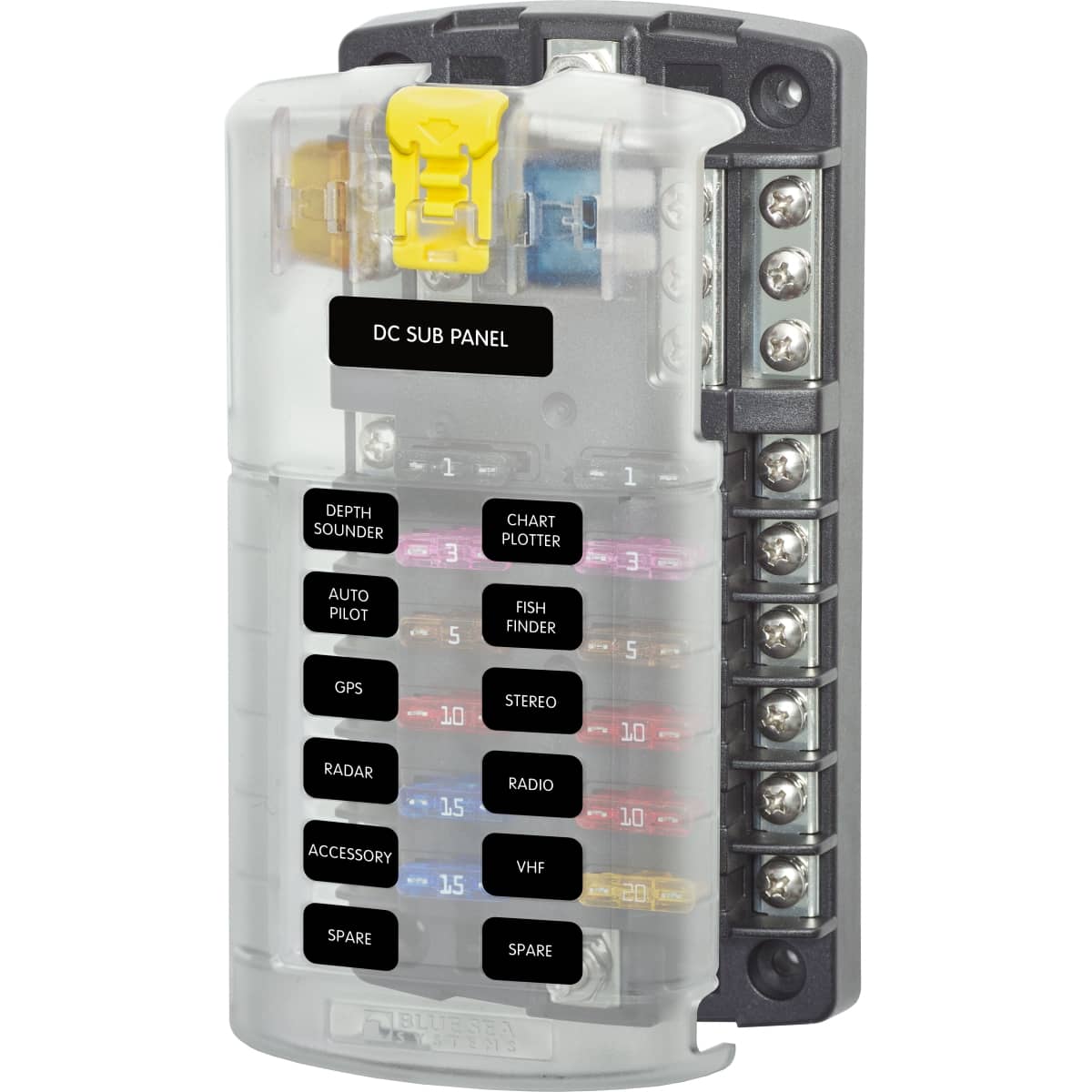Getting My Blue Sea Fuse Block To Work
Wiki Article
The Buzz on Blue Sea Fuse Block
Table of ContentsIndicators on Blue Sea Fuse Block You Should KnowSome Ideas on Blue Sea Fuse Block You Should KnowNot known Details About Blue Sea Fuse Block Blue Sea Fuse Block Things To Know Before You Get ThisTop Guidelines Of Blue Sea Fuse BlockThe 20-Second Trick For Blue Sea Fuse Block
Fuses are bolted in position between the bus bar and the 2nd set of electrically isolated bolts. With this setup you can affix the boat's numerous high-current circuits, such as a windlass, bow thruster, high-output alternator, the DC panel, etc, to the isolated screws. The different integrates are sized according to the current-carrying ability of the conductors bolted to them.Some circuits will still need to bypass the seclusion switch to make sure that they may be left on when the remainder of the watercraft is shut down. blue sea fuse block. These circuits normally consist of a bilge pump and also any charging tools (including photovoltaic panels, maybe a wind generator, and the inverter if it additionally functions as a battery charger).
This belongs to the circuit diagram we established for the complicated example watercraft in our Watercraft Electrics program. The devices attached to the fuse block in the top right are all bypassing the seclusion switch S1. If you register for Watercraft Electrics 101, you will learn exactly how to review such a diagram and likewise how to make one for your own watercraft.
Indicators on Blue Sea Fuse Block You Should Know

With DC circuits, the OCP is always positioned in the positive side of DC circuits. Note that some European boatbuilders install fuses and also battery switches in the DC negative side and also on the positive side, yet this is not advised except in some separated (floating) ground DC systems.
This factor may go to the battery, the battery button, the distribution panel, a subsidiary panel, some circulation bus bar, or various other linking point. If the conductors in the new circuit are no smaller sized than the conductor that feeds the brand-new circuit's factor of link, then the OCP for the feeder conductor will sufficiently shield the brand-new circuit - blue sea fuse block.
What Does Blue Sea Fuse Block Do?
If the brand-new circuit is not properly offered by overcurrent gadgets already in location, extra defense is needed at its point of link, i. e., at its resource of power. Placement of merges in the positive conductor. Note exactly how a smaller fuse is utilized whenever a smaller sized conductor is attached, Often room limits how close an OCP gadget can be positioned to the source of power.The common response, from the ABYC, is within 7" (17. The ABYC enables the complying with, which have actually been tightened up in recent years: A conductor linked directly to a battery that is also "had throughout its whole range in a sheath or room such as an avenue, joint box, control box or encased panel" should have its overcurrent protection "as close as possible to the battery, however not to surpass 72 inches (1.
Gone is the covering 72" allowance that utilized to be there. A conductor linked to a resource of power apart from the battery (e. g., the battery switch, the circulation panel, or a few other point in the DC circuits) that is in a similar way contained in a sheath, etc, have to have its overcurrent security "as close as possible to the factor of connection to the source of power, but not to exceed 40 inches (1.
All about Blue Sea Fuse Block
e., anywhere it connects right into the DC system. Considered that alternators themselves provide power, it has been arguable whether these included generators called for OCP at the alternator itself. This has been resolved in the current version of the ABYC E-11 standard as adheres to: "Overcurrent security is not needed at a generator if the ampacity of the conductor is equivalent to or above the ranked outcome of the alternator."Cranking-motor circuits are not required to have overcurrent security.In the marine field, where cranking circuits might be long, this technique may produce a danger. It makes no feeling to have any type of unguarded circuits on a boat.
In winter, the inrush present on a 12V starter electric motor might be as high as 1,500 amps; the cranking current might be as long as 200 amps. Commonly, cranking conductors are undersized even for the cranking present, not to mention the inrush present. This situation does not pose a safety issue per se, because these currents are endured for just a few secs, so the conductors do not have time to get hot sufficient to create a fire risk.
Rumored Buzz on Blue Sea Fuse Block
We made the course with outright beginners in mind. As the electrical tons on boats increases, so as well does the complexity of electric circuits and also the possibility for short circuits as well as look at these guys electric fires.
In the marine field, where cranking circuits might be long, this practice could develop a hazard. It makes no feeling to have any type of unguarded circuits on a watercraft.
The Only Guide to Blue Sea Fuse Block

We made the course with absolute newbies in mind. As the electric tons you can try here on boats boosts, so too does the intricacy of electric circuits as well as the possibility for short circuits and electric fires.
Report this wiki page